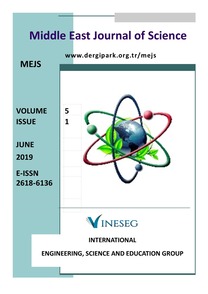APPLICATION OF NEW ITERATIVE ALGORITHM FOR THE NUMERICAL SOLUTION OF NONLINEAR CONVECTION-DIFFUSION EQUATION WITH CONSTANT COEFFICIENTS
Abstract: This paper presents computational procedures for the formulation of an algorithm based on the new iterative method (NIM) for the numerical solution of the nonlinear heat equation with constant coefficients. The newly formulated algorithm (NIA) was successfully described the relationship between convection and diffusion constants. Three test cases (prototype) are considered for the investigation oftime distribution profiles in the heat equation other studies. The algorithm is easy, efficient, and suggests solving similar problems in physical sciences and engineering.
___
[1] M. C. Methods, “Solving nonlinear and high-dimensional partial differential equations via deep learning”, EMAp, Fund. Getulio Vargas, Rio Janeiro, Brazil, vol. I, 2019.[2] S. G. Ahmed, “A numerical algorithm for solving advection-diffusion equation with constant and variable coefficients”, The open Numerical Methods Journal, 3, 59-65, 2011.
[3] R. Kragler, “Solution of 1D/2D advection-diffusion equation using the method of inverse differential operators (MIDO) ”, Conference Paper Weingarten University of Applied Sciences D-88241 Weingarten, Germany pp1-15, 2015.
[4] A. Kumar, D. K. Jaiswal, and N. Kumar, “Analytical solutions of one-dimensional advection – diffusion equation with variable coefficients in a finite domain”, Journal of Earth System Science, 118, 539–549, 2009.
[5] D. K Jaiswal, A. Kumar, R. R. Yadav "Analytical Solution to the One-Dimensional AdvectionDiffusion Equation with Temporally Dependent Coefficients", Journal of Water Resource and Protection, 3, 76-84, 2011.
[6] A. Peirce, “Heat conduction with time-dependent boundary conditions using eigen-function expansions”, Introductory lecture notes on partial differential equations, 1-9, 2020.
[7] J. Biazar and H. Ghazvini, “Homotopy perturbation method for solving hyperbolic partial differential equations”, Computer and Math. With Appl., 56(2), 453-458, 2008.
[8] M. Dehghan, “On the numerical solution of the one-dimensional convection-diffusion equation”, Hindawi Publishing Corporation Mathematical Problems in Engineering, 61–74, (1)2005.
[9] M. Yaseen and M. Samraiz, “The modified new iterative method for solving linear and nonlinear Klein Gordon equations new iterative method”, Applied Mathematical Sciences, 6(60), 2979 – 2987, 2012.
[10] R. Behl, A.Cordero, J. R. Torregrosa and A. S. Alshomrani “new iterative methods for solving nonlinear problems with one and several unknowns”, MDPI sum Mathematics, 6, 296, 2018.
[11] S. Bhalekar, and V. Gejji, “new iterative method : application to partial differential equations”, Applied mathematics and computation, 203, 778-783, 2008.
[12] C. Chun, “A new iterative method for solving nonlinear equations”, Applied mathematics and computational, 178, 415–422, 2006.
[13] J. S. Pérez Guérrero, L. C. G. Pimentel, T. H. Skaggs, M. Th. VanGenuchten, “Analytical solution of the one-dimensional advection-diffusion transport equation using a change of variable and integral transform technique”, Int. J. Heat and Mass Transfer, 52, 3297-3304, 2009.
[14] K.M Singh, M. Tanaka “On exponential variable transformation based boundary element formulation for advection-diffusion problems”, Eng anal bound element, 24, 225-35, 2000.
[15] L.L.Takacs, “A two-step scheme for the advection equation with minimized dissipation and dispersion errors”, Monthly Weather Review, 113(6), 1050–1065, 1985.
[16] D. Z. Turner, K. B. Nakshatrala and K. D. Hjelmstada “Stabilized finite element formulation for advection-diffusion using the generalized finite element framework”, https://www.researchgate 2008.
[17] A. Masud and R. A. Khurram. “A multiscale/stabilized finite element method for the advection- diffusion equation”, Computer Methods in Applied Mechanics and Engineering, 193, 1997– 2018, 2004.
- ISSN: 2618-6136
- Yayın Aralığı: Yılda 2 Sayı
- Başlangıç: 2015
- Yayıncı: INESEG Yayıncılık
Sayıdaki Diğer Makaleler
Muharrem ERGUN, Zahide SÜSLÜOĞLU
Cansu BAŞARAN CANER, Sait ENGİNDENİZ, Zhansaya BOLOTOVA
Falade KAZEEM IYANDA, Muhammad MUSTAPHA
DETECTION OF SOME VIRULENCE GENES AND GENETIC VARIATIONS OF ACINETOBACTER BAUMANNII
Muharrem ERGUN, Zahide SÜSLÜOĞLU
Nazan DEMİR, Sıla Nezahat DAŞDEMİR, Alevcan KAPLAN
DETECTION OF SOME VIRULANCE GENES AND VARIATION OF Acinetobacter Baumannii
